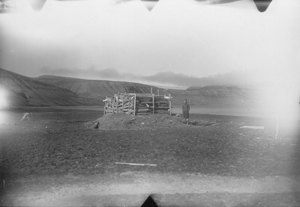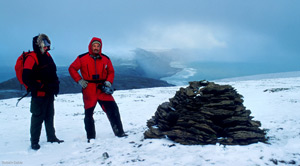Hopen's history and cultural remains
By Kristin Prestvoldhttp://cms2.npolar.no/system/workplace/editors/xmlcontent/editor_form.jsp#
 Rudihytta/Sørhytta at Koefoedodden pictured in the 1930s. (Image: Thor Askheim / The Norwegian Polar Institute Photo Library) Rudihytta/Sørhytta at Koefoedodden pictured in the 1930s. (Image: Thor Askheim / The Norwegian Polar Institute Photo Library)
The oldest cultural remain on Hopen is a blubber oven by a slaughtering site for walrus in Koefoedodden, in the south-east of the island. There are also several cabins from the period of Norwegian overwintering hunting. Hopen used to be a hunting ground, and it was seen as good polar bear country. Arctic foxes and seabirds were also plentiful.
Some of the cabins have decayed. The following have been declared worthy of preservation according to the Plan for Memorials in Svalbard 2000-2010. (The names of the cabins used here are as referred to by the plan).
- Rudihytta, from 1908, is situated at the point of Koefoedodden and was built by a team of hunters, led by Salomon Fylkesnes, from Ålesund. This cabin also goes by the name of Sørhytta.
- Another cabin on Koefoedodden, also known as Sørhytta, was in 1995 by the Meteorological Institute and the Norwegian Polar Institute. There is beacon close by.
- Russehytta (also called Nordhytta) can be found in the east of the island, in Hermansenskaret. It was built in 1908. For a while this cabin was home to the three survivors of the Russian ship Dekabrist, which was torpedoed and sank in November 1942. A memorial was erected in 1987, in memory of those who perished. Nearby there is another cabin – it was built in 1971 and is called Bjørnebo.
- Nilsebu, from 1908 and repaired in 1973, is situated by the Meteorological Institute’s station/Hopen Radio in Husdalen. Nilsebu was used as a weather station for German troops between October 1943 and 5 August 1945.
 Thor Iversens's cairns. Eastern cairn on Iversenfjellet. (Image: The Iversen/Bukholm collection) Thor Iversens's cairns. Eastern cairn on Iversenfjellet. (Image: The Iversen/Bukholm collection)
A hunting expedition led by Ludolf Schjelderup built two cabins by Braastadskaret, in the north of the island, in 1923. One of these, Beisarhytta, was demolished in 1973 and a new cabin was erected in its place. It was refurbished in 2005. Johshytta can be found in Bjørnstranda, north-west of the meteorological station. It was built in 1956, but cannot be used anymore. Four cairns built in 1924 are important memorials for polar research expeditions. Thor Iversen and his men built two cairns on Iversenfjellet, one on Werenskioldfjellet and one on Kollerfjellet. They undertook geographical measurements and collected plant and rock samples.
Today’s activities
The Meteorological Institute’s station has been running since 1947. Today four people work there, and the crew is swapped twice a year. The station has also been used as a base for polar bear field work in Storfjorden and the eastern areas of Svalbard. Other than that, there is no regular scientific activity taking place on the island.
In the 1970s two exploratory wells for petroleum were drilled in Hopen, without finding anything.
Tourism on Hopen is limited. Each year 100-150 summer tourists are brought to Hopen, where they are allowed to come on shore by the meteorological station.
|